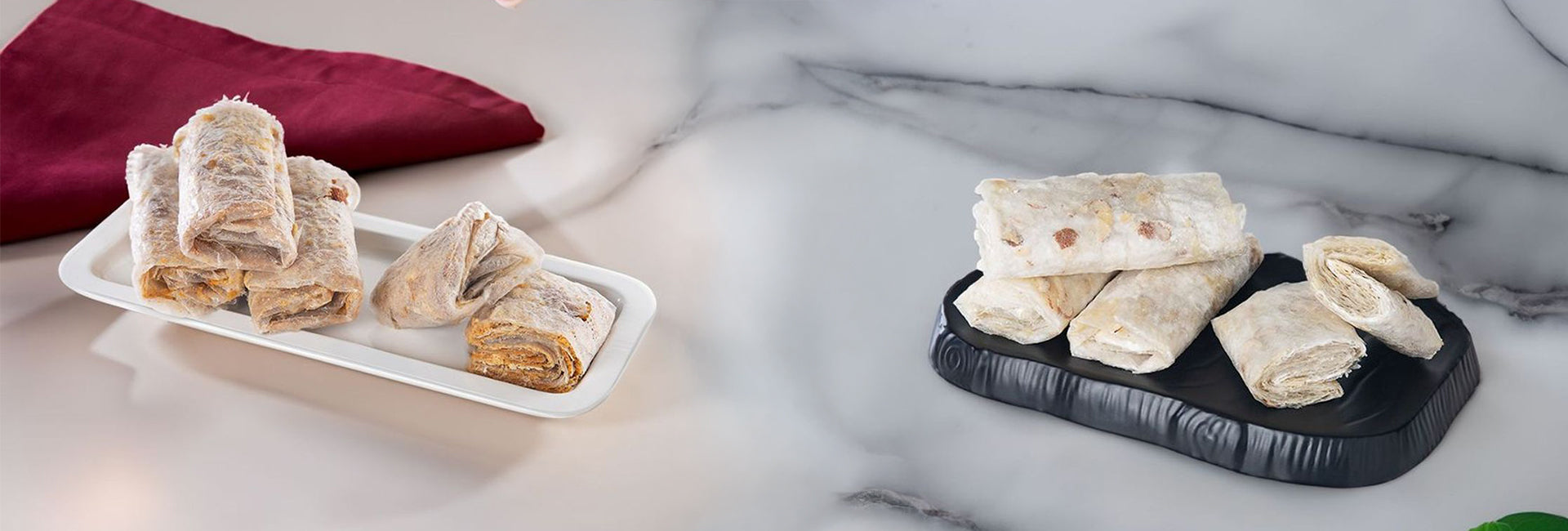Pootharekulu, the Silken Sweet of Andhra: Bellam vs. Sugar

-
What exactly is Pootharekulu?
Pootharekulu—literally “coated sheets” in Telugu (pootha = coating, reku/rekulu = sheet/sheets)—was born in the Godavari delta, most closely associated with the village of Atreyapuram in today’s Konaseema district of Andhra Pradesh. The sweet’s identity is inseparable from this place: for generations, families here have practiced the delicate craft of pulling whisper-thin rice-starch films, brushing them with ghee, and folding in a filling of sugar or jaggery.
Local memory and food writing place Pootharekulu’s origins a few centuries back. A popular origin tale says a village woman noticed a paper-thin skin of rice starch on the outside of a cooking pot and turned that accident into a method: make a runny rice batter, “kiss” it onto a hot inverted pot to lift a translucent sheet, then layer it with sweetness. Whether or not the story is exact, the technique it describes is still the backbone of the craft today.
By the late 19th and 20th centuries, Pootharekulu had become a festive essential across the Godavari region—wedding trays, temple offerings, and festival boxes always made room for these fragile parcels. The work settled naturally into a cottage industry in Atreyapuram, with many households specializing in different parts of the process: grinding rice, seasoning the pot, pulling sheets, powdering sugar or jaggery, and careful folding. Even now, the sweet is closely tied to women’s skilled artisanal labor, while men traditionally handled the marketing and travel to nearby towns. -
Bellam vs. Sugar: Two paths to bliss
Bellam Pootharekulu (Jaggery)
- Taste: Deep, caramelly sweetness with mineral warmth and notes of molasses.
- Texture: Slightly fudgier finish as jaggery clings to the layers.
- Aroma: Earthy, nostalgic, and ghee-forward.
- Best for: Traditionalists, festive platters, those who love richness and depth.
Try: Mithaicana Bellam Pootharekulu
Sugar Pootharekulu- Taste: Clean, bright sweetness that lets the rice sheet and ghee shine.
- Texture: Extra-light crackle with a pristine, crisp finish.
- Aroma: Subtle, delicate—great for pairing with tea or coffee.
- Best for: First-timers, gifting, and those who prefer a lighter profile.
-
How the magic (carefully) happens
Great Pootharekulu is as much about patience as it is about ingredients:
- The sheet: Made from select rice, finely ground and rested to achieve the right fluidity.
- The heat: Consistent, gentle heat is key; too hot and the sheet shatters, too cool and it won’t lift.
- The layers: A brush of ghee (for aroma and cohesion) plus a fine sweetener (to avoid tearing and ensure even melt).
- The fold: Swift and light—overwork and you lose the airy structure that defines Pootharekulu.
Every piece looks simple; every piece takes skill.
-
Why Mithaicana’s Pootharekulu stands out
- Ingredient integrity: Clean, quality ghee and carefully sourced sweeteners.
- Artisanal make: Hand-layered sheets for that ethereal crackle.
- Freshness first: Packed to preserve crispness from our kitchen to your celebration.
- Two classic profiles: Choose the nostalgic depth of Bellam or the crystal clarity of Sugar.
-
How to serve Pootharekulu (and make it feel special)
- Classic platter: Mix Bellam and Sugar for contrast—alternate pieces for visual appeal.
- After-meal delight: Serve with warm milk, filter coffee, or masala chai.
- Festive garnish: Plate with roasted nuts or edible dried rose petals.
- Mini dessert board: Pair with fresh fruit (slices of pear, banana, or strawberries).
- Crumbled magic: Break gently over vanilla ice cream or payasam for textural sparkle.
-
Frequently asked questions
- Is Pootharekulu overly sweet?
It’s sweet, yes—but the rice-paper layers and ghee balance it beautifully. Bellam brings a richer, more rounded sweetness, while Sugar feels lighter and cleaner.
- Which variety should I choose for gifting?
When in doubt, go half-and-half. A mixed box of Bellam and Sugar pleases all palates.
- Is it vegetarian?
Yes. Traditional Pootharekulu uses rice, ghee, and sugar or jaggery—no eggs.
- Does it travel well?
Packaged thoughtfully, it does. Keep away from heat and moisture, and handle lightly.
- How is it different from Mysorepak?
Mysorepak is dense and fudgy; Pootharekulu is feather-light and layered. Both rely on ghee—but the mouthfeel and structure are worlds apart.
- Is Pootharekulu overly sweet?
